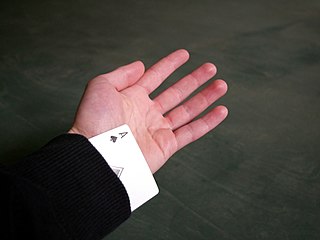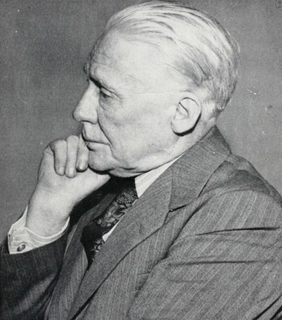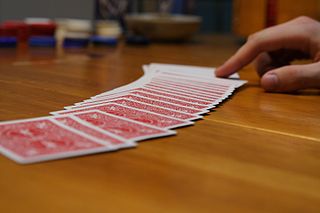Related Research Articles

Cheating in poker is any behavior outside the rules that is intended to give an unfair advantage to one or more players.
Sleight of hand refers to fine motor skills when used by performing artists in different art forms to entertain or manipulate. It is closely associated with close-up magic, card magic, card flourishing and stealing. Because of its heavy use and practice by magicians, sleight of hand is often confused as a branch of magic; however, it is a separate genre of entertainment and many artists practice sleight of hand as an independent skill. Sleight of hand pioneers with worldwide acclaim include Dan and Dave, Ricky Jay, Derek DelGaudio, David Copperfield, Yann Frisch, Norbert Ferré, Dai Vernon, Cardini, Tony Slydini and Helder Guimarães.

Card manipulation is the branch of magic that deals with creating effects using sleight of hand techniques involving playing cards. Card manipulation is often used in magical performances, especially in close-up, parlor, and street magic. Some of the most recognized names in this field include Dai Vernon, Tony Slydini, Ed Marlo, S.W. Erdnase, Richard Turner, John Scarne, and Ricky Jay. Before becoming world-famous for his escapes, Houdini billed himself as "The King of Cards". Among the more well-known card tricks relying on card manipulation are Ambitious Card, and Three-card Monte, a common street hustle also known as Find the Lady.

A one-way deck is a deck of playing cards where the back of the cards has a pattern that can be oriented to have a "top" and "bottom". Magicians and card sharps can use the orientations of cards in one-way decks to encode information that allows them to perform card tricks.
A trick deck is a deck of playing cards that has been altered in some way to allow magicians to perform certain card tricks where sleight of hand would be too difficult or impractical.
The Ambitious Card, or Elevator Card, is a magic effect in which a playing card seems to return to the top of the deck after being placed elsewhere in the middle of the deck. This is a classic effect in card magic and serves as a study subject for students of magic. Most performing card magicians will have developed their own personal Ambitious Card routine.

Cardistry is the performance art of card flourishing. Unlike card magic, cardistry is meant to be visually impressive and appear very hard to execute.

Dai Vernon, a.k.a. The Professor, was a Canadian magician. His sleight of hand technique and knowledge, particularly with card tricks and close-up magic, garnered him respect among fellow magicians, and he was a mentor to other magicians. He lived out his last years at Magic Castle, a nightclub in Hollywood, California.
Out of This World is a card trick created by magician Paul Curry in 1942. Many performers have devised their own variations of this trick. It is often billed as "the trick that fooled Winston Churchill" due to a story describing how it was performed for him during World War II. The method behind the trick is simple and essentially self-working, and can be enhanced by the presentation of the performer and the use of other principles of magic.
Self-working magic is a commonly used term in magic to refer to tricks that work simply from following a fixed procedure, rather than relying on trickery, sleight-of-hand, or other hidden moves.
A double lift is a sleight of hand maneuver used by magicians in card magic. It is a method by which the identity of the top card may be kept secret by lifting the top two cards as one, making it seem as if only the top card is picked up. Similar techniques may be applied to more than two cards to perform a triple or even quadruple lift. The term was coined by Theo Annemann.
This is a glossary of conjuring terms used by magicians.
The Twenty-One Card Trick, also known as the 11th card trick or three column trick, is a simple self-working card trick that uses basic mathematics to reveal the user's selected card.
Spelling Bee may refer to one of several card tricks that revolve around the spelling of card types, audience member names, or words suggested by the audience. Many make use of decks prepared in advance in order to provide the illusion of spelling card names in a particular sequence. Jean Hugard's Encyclopedia of Card Tricks lists a number of such spelling-based tricks, many of which are considered to be self-working.
The Si Stebbins stack is a cyclic mathematical card stack. It was popularized by the magician Si Stebbins, and can be constructed from a standard 52-card deck. Frequently used in card magic, its properties allow the position and value of each card in a deck to be determined.

Chink-a-chink is a simple close-up magic coin trick in which a variety of small objects, usually four, appear to magically transport themselves from location to location when covered by the performer's hands, until the items end up gathered together in the same place. Variations, especially the Sympathetic Coins also known as Coins-n-Cards, have been performed since the 1800s. Popular modern variations are Shadow Coins and Matrix. A variation using playing cards as the objects is known as Sympathetic Aces.

Jean Hugard was an Australian professional magician.
Frederick Braue[pronounced BROW-ee] was an American journalist notable for his contribution to the field of card magic. He was a semi-professional magician, specializing in card magic, of which he was a master.

In stage magic, a force is a method of controlling a choice made by a spectator during a trick. Some forces are performed physically using sleight of hand, such as a trick where a spectator appears to select a random card from a deck but is instead handed a known card by the magician. Other forces use equivocation to create the illusion of a free decision in a situation where all choices lead to the same outcome.
References
- 1 2 3 4 Hugard, Jean; Braue, Frederick (1999-05-27). yesbhutdbj20Card%20Trick%22 The Royal Road to Card Magic. Courier Corporation. pp. 138–139. ISBN 9780486408439.
{{cite book}}: Check|url=value (help) - 1 2 3 4 5 6 Hugard, Jean; Braué, Frederick (2012-04-30). Expert Card Technique. Courier Corporation. p. 398. ISBN 9780486156538.
